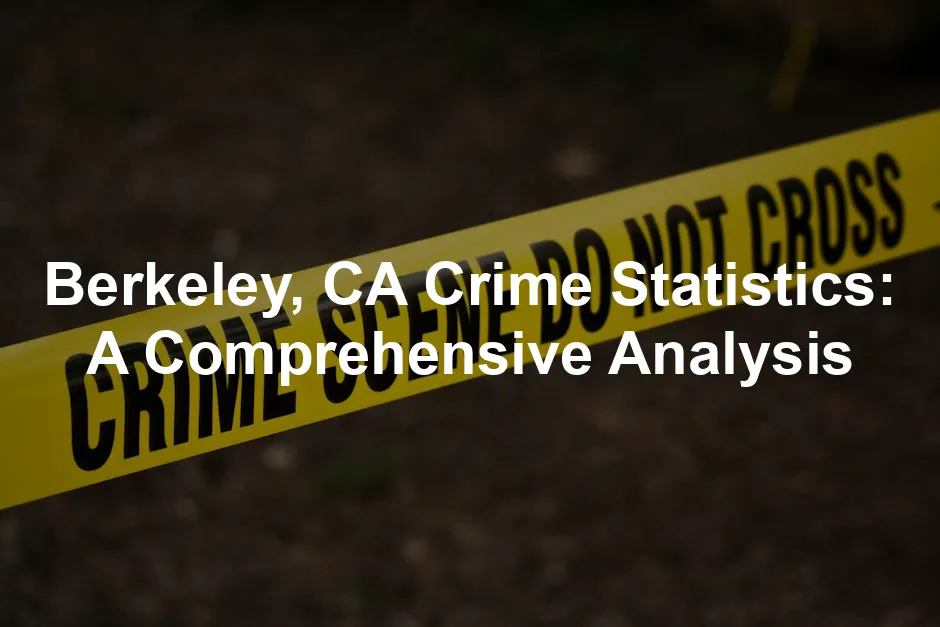Introduction
Understanding crime statistics in Berkeley, CA, is crucial. It helps residents, potential movers, and policymakers make informed decisions. With a vibrant culture, renowned university, and diverse population, Berkeley presents a unique urban landscape. However, this lively city faces various urban challenges, including crime. Crime statistics serve as a lens through which we can view the community’s safety. They reveal trends that affect daily life. For residents, knowing the crime landscape can influence choices about where to live, work, or study. Potential movers may weigh this data against their desire for a safe environment. Policymakers use crime statistics to shape effective community programs and resource allocation. In recent years, Berkeley has seen a noticeable fluctuation in crime rates. Issues such as property theft and violent crime have raised concerns. These factors create a pressing need for transparency and awareness. Local reports and studies, including those from the Berkeley Police Department and independent research agencies, will be referenced. These sources provide reliable data to better understand the current state of crime in Berkeley. By analyzing crime statistics, we can identify patterns over time. This insight fosters community awareness and encourages dialogue about safety measures. Recognizing the importance of this data allows residents to become proactive in addressing crime concerns. As we move forward, it’s essential to keep an eye on the evolving crime trends in Berkeley. This comprehensive analysis aims to equip readers with the knowledge needed to navigate the complexities of urban safety. For those interested in enhancing their personal safety, consider investing in a Home Security Camera System to keep an eye on your property, especially during these uncertain times.Understanding data interpretation is critical for analyzing crime statistics effectively. an introduction to statistical learning with Python can be a valuable resource.
Understanding Crime Statistics
Crime statistics are a collection of data that reflects the frequency and types of crime in a specific area. They are essential for urban studies, as they highlight community safety and security. Knowing what these statistics entail can empower residents and local leaders alike. Crime typically falls into two categories: violent and property crimes. Violent crimes include offenses that directly harm individuals, such as murder, assault, and robbery. Property crimes involve theft or destruction of property, like burglary and vehicle theft. Understanding these distinctions is vital for grasping the broader implications of crime in Berkeley. When discussing crime rates, it’s common to express data in terms of incidents per 1,000 residents. This method allows for a clearer comparison between different communities, regardless of population size. For instance, if Berkeley has a total crime rate of 70 per 1,000 residents, it provides a direct context to assess safety against other cities. Analyzing crime statistics also entails examining trends over time. When looking at data from past years, one can identify whether crime rates are rising or falling. This knowledge helps residents gauge their safety and understand the effectiveness of law enforcement strategies. Moreover, crime statistics can guide local initiatives aimed at crime prevention. By pinpointing specific areas or types of crime that require attention, communities can allocate resources efficiently. Ultimately, understanding crime statistics is a crucial step toward fostering a safer Berkeley for all. To further enhance personal safety, consider a Personal Safety Alarm—a small device that can make a big difference in emergencies.
How Crime Statistics Are Collected
Crime statistics are vital for understanding the safety landscape of a community. But how are these numbers actually gathered? Local police departments play a crucial role in compiling crime data. They collect reports on every incident, from petty thefts to serious assaults. This data is then sent to the FBI, which aggregates information from law enforcement agencies nationwide. This collaboration helps create a clearer picture of crime trends across the country. However, it’s not all sunshine and rainbows. There are limitations and potential inaccuracies in crime reporting. For instance, not all crimes are reported. Some victims may choose to remain silent due to fear or distrust of law enforcement. Others may feel their situation isn’t serious enough to warrant police involvement. This can lead to underreporting, skewing the statistics. Additionally, discrepancies in classification can arise. A crime that one officer deems serious may be considered a minor offense by another. These inconsistencies can muddy the waters when trying to assess overall safety. Therefore, while crime statistics are valuable, they should be interpreted with caution. Understanding their collection process is essential for making informed decisions about safety and community resources. If you’re concerned about personal safety, consider investing in Pepper Spray for Self Defense—a practical tool for personal protection.Berkeley, CA Crime Overview
General Crime Rates in Berkeley
Berkeley, CA, has garnered attention for its crime rates, which significantly exceed national and state averages. With a total crime rate of approximately 70 incidents per 1,000 residents, the city ranks among the higher crime locations in America. In comparison, the national average hovers around 36 per 1,000 residents. This stark difference brings the safety of Berkeley into sharp focus. When breaking down the statistics, we find a violent crime rate of 6.55 per 1,000 residents. This is notably higher than California’s state average of 4.1. Property crimes tell an even grimmer story, with a staggering rate of 63.32 per 1,000 residents, substantially higher than the national average of 22.0. Investing in Smart Door Lock can improve your home security significantly. Yearly comparisons reveal troubling trends. From 2022 to 2023, the city saw a 10.5% increase in Part I crimes, which include serious offenses like murder, robbery, and aggravated assault. Specifically, robbery incidents jumped by 32.2%, and auto thefts soared by 61.5%. Such increases prompt serious concerns among residents and local authorities alike. Data from NeighborhoodScout, Niche, and the Berkeley Police Department provide a foundation for these insights. Each source brings valuable information, offering a comprehensive view of crime dynamics in the city. As Berkeley continues to face challenges with crime, residents must remain informed and vigilant.
Violent Crimes in Berkeley
Violent crimes in Berkeley comprise a range of alarming offenses. The categories include murder, rape, robbery, and aggravated assault. Analyzing the statistics reveals significant trends. In 2023, there were three reported murders, a slight decrease from previous years. However, the number of rapes increased to 104 from 89 in 2022, raising concerns about safety, particularly for women. Robberies have emerged as a major problem. With a total of 320 incidents reported, the robbery rate stands at an unsettling 2.69 per 1,000 residents. The rise in pedestrian robberies and carjackings has created an atmosphere of fear among residents. Aggravated assaults accounted for 352 incidents, underscoring the persistent threat of violence in the city. These violent crime statistics paint a worrying picture, indicating that Berkeley is not immune to the broader trends observed in urban areas across the nation. As law enforcement strives to combat these issues, community support and awareness become paramount. Understanding the nature of these crimes can help residents take precautions to enhance their personal safety. A Motion Sensor Floodlight can illuminate dark areas and deter potential threats.Property Crimes in Berkeley
Berkeley has its fair share of property crimes. These offenses include burglary, theft, and motor vehicle theft. Understanding these types helps residents stay vigilant and secure. Burglary is a common concern in Berkeley. In 2023, there were approximately 1,090 reported burglaries. This translates to a rate of 9.16 incidents per 1,000 residents. Surprisingly, burglaries saw an increase of 18.5% from the previous year. This uptick raises eyebrows and prompts questions about security measures in the city. Theft is another significant issue. With 5,200 reported thefts, it’s the most frequent property crime. The theft rate stands at a whopping 43.72 per 1,000 residents. This includes shoplifting and other petty crimes. The community must remain alert to deter would-be thieves. Motor vehicle theft continues to plague the city as well. In 2023, there were 1,242 vehicles reported stolen, resulting in a rate of 10.44 per 1,000 residents. This marks a staggering increase of 61.5% from the previous year. Carjackings have also risen, contributing to an overall sense of unease among residents. Investing in a Bicycle Lock can help protect your property. The impact of these crimes resonates throughout the community. High property crime rates can lead to increased insurance premiums and a decline in property values. Residents may feel less secure in their neighborhoods, prompting them to invest in security systems or adopt neighborhood watch programs. When comparing Berkeley’s property crime rates to neighboring cities, it’s evident that the situation is dire. For example, the property crime rate in California averages around 22 incidents per 1,000 residents. Berkeley’s numbers are significantly higher, which places a spotlight on the need for effective crime prevention strategies. Visual representation can help clarify these trends. Charts and graphs showing year-over-year changes in property crimes can provide insights into patterns and highlight areas for improvement. By capturing this data, residents can better understand where to focus their safety efforts. For a comprehensive approach to safety, consider having a First Aid Kit on hand for emergencies.
Comparative Analysis with Nearby Areas
When we zoom out and compare Berkeley’s crime statistics with those of nearby cities like Oakland, Albany, and San Francisco, a broader picture emerges. It’s crucial to understand how these areas stack up against one another to gauge safety and community dynamics. Berkeley’s total crime rate stands at about 70 incidents per 1,000 residents, which is significantly higher than the state and national averages. In contrast, Oakland, notorious for its crime rates, has a total crime rate of approximately 84 incidents per 1,000 residents. While that figure may sound alarming, it highlights the ongoing challenges both cities face. Albany, on the other hand, paints a different picture. With a crime rate of around 27 incidents per 1,000 residents, Albany is markedly safer than both Berkeley and Oakland. This stark difference raises questions about community resources and law enforcement strategies in these neighboring cities. San Francisco, a bustling metropolis, reports a crime rate similar to Berkeley’s, hovering around 78 incidents per 1,000 residents. The types of crimes vary, with San Francisco battling property crimes like theft and burglary at a high rate, while Berkeley deals with a mix of violent and property crimes at concerning levels. When analyzing regional patterns, one can observe that urban areas tend to share common challenges. For instance, car thefts are a significant issue in both Berkeley and Oakland. This trend aligns with observations from national crime statistics, where urban centers often report higher rates of auto theft and robbery. In summary, while Berkeley’s crime statistics are concerning, they fit into a larger context of urban crime trends seen throughout the region. Understanding these comparisons can help residents and policymakers strategize about improving safety and community well-being. To assist in emergency situations, consider having a Emergency Preparedness Kit ready at home.
Community Perception and Safety
Community Sentiment on Safety
In the heart of Berkeley, community sentiment towards safety reveals a complex and often contradictory picture. Survey data indicates that while some residents feel secure, a significant portion express concerns about their safety. In fact, a recent poll indicates that 50% of respondents feel “somewhat safe,” while only 6% report feeling “very safe.” This statistic speaks volumes about the palpable anxiety felt by many locals. The trust in law enforcement effectiveness also plays a pivotal role in shaping this sentiment. Approximately 38% of residents perceive police as visible but slow to respond. This perception can lead to feelings of helplessness, particularly during times of crisis. Further complicating matters, a significant number of residents—about 31%—believe that police presence is both visible and responsive. However, this leaves a concerning gap where trust could be strengthened. The implications of these sentiments are profound. Many residents might hesitate to engage in community activities or venture out after dark, which can stifle social cohesion. Public trust in law enforcement is crucial for effective policing and community safety. If residents feel disconnected from their police force, they may be less likely to report crimes or collaborate on community safety initiatives. To bridge these gaps, proactive measures are necessary. Community engagement efforts, such as neighborhood watch programs and public safety meetings, can foster dialogue between residents and law enforcement. By working together, both parties can develop strategies to address safety concerns while nurturing a sense of belonging. In conclusion, understanding community sentiment and trust in law enforcement is vital for enhancing safety in Berkeley. By addressing these concerns through open communication and collaboration, residents can create a more secure and welcoming environment for all. For added safety while traveling, a Travel Safety Kit can be a smart investment.
Law Enforcement and Safety Initiatives
Berkeley’s approach to crime reduction relies heavily on proactive law enforcement and community engagement. With a total crime rate of 70 per 1,000 residents, the city faces significant staffing challenges in its police department. Currently, the Berkeley Police Department (BPD) is short about 30 officers out of an authorized strength of 181. This staffing shortage has persisted, marking the lowest levels since at least 2006. To combat this issue, the BPD has launched recruitment efforts targeting a diverse range of candidates. Their goal? To build a more representative and effective police force. Efforts to attract new officers include community job fairs and partnerships with local colleges. By reaching out to potential recruits in various environments, BPD aims to create a stronger connection with the community. This approach not only helps in addressing the staffing crisis but also fosters a sense of trust and transparency. After all, who wouldn’t feel more secure knowing their officers live in the same neighborhoods they patrol? Community engagement programs play a pivotal role in crime reduction as well. Initiatives like neighborhood watch groups encourage residents to collaborate with law enforcement. These programs have shown remarkable effectiveness in creating safer communities. Studies indicate that neighborhoods with active watch programs tend to experience lower crime rates. To complement these efforts, consider investing in a Neighborhood Watch Sign to enhance community awareness. Additionally, outreach programs focusing on youth are helping to build positive relationships between officers and younger community members. Programs that involve local schools and recreational activities help foster a sense of belonging and security. By investing in the youth, Berkeley is laying a foundation for a safer future. In summary, Berkeley’s law enforcement initiatives focus on addressing staffing challenges while creating strong community ties. These efforts aim to not just reduce crime but to build trust and enhance the overall safety of the city. A collaborative approach ensures that residents can feel empowered and engaged in their community’s safety efforts.
FAQs
What is the overall crime rate in Berkeley compared to national averages?
Berkeley’s overall crime rate stands at about 70 incidents per 1,000 residents. This is significantly higher than the national average of 36 per 1,000. In Berkeley, the chance of becoming a victim of a crime is 1 in 17, which puts it among the higher crime cities in America.
How does Berkeley handle crime prevention?
Berkeley emphasizes community policing and outreach programs. The Berkeley Police Department collaborates with residents to address safety concerns. Initiatives like neighborhood watches and youth engagement programs foster trust and communication.
Are there specific neighborhoods in Berkeley that are safer than others?
Yes, neighborhoods like Kensington and Claremont are known for their lower crime rates. In contrast, areas closer to downtown may experience higher rates of property crimes and pedestrian robberies.
What resources are available for residents to report or learn about crime?
Residents can access crime data through the Berkeley Police Department’s website. They can also report incidents online or through community meetings. Resources like local crime maps and annual reports help keep the community informed.
Conclusion
Staying informed about crime statistics and trends in Berkeley is vital for residents. Understanding crime patterns empowers individuals to make informed decisions about their safety. Recent statistics show fluctuations in crime rates, prompting a proactive response from law enforcement and the community alike. Crime prevention efforts involve not just police initiatives but also community engagement. Collaborations between law enforcement and residents foster a sense of security and trust. Programs that focus on youth and neighborhood involvement are particularly effective in creating a safer environment. Don’t forget to keep a Fire Extinguisher handy as part of your emergency preparedness. As crime trends continue to evolve, residents must remain vigilant and engaged. Knowledge is power, and understanding the dynamics of crime in Berkeley is crucial. By participating in community programs and staying informed, residents contribute to a safer, more resilient city. Together, the community and law enforcement can work towards reducing crime and enhancing the quality of life for everyone in Berkeley. So, keep an eye on those crime statistics and remember: safety is a community effort! And to ensure safety on the road, consider using LED Road Flares during emergencies.Please let us know what you think about our content by leaving a comment down below!
Thank you for reading till here 🙂
All images from Pexels




